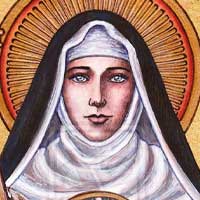Hildegard of Bingen Biography - A Very Quick Guide
Artist:
Hildegard of Bingen
Born:
c.1098
Died:
17 September 1179
Hildegard of Bingen was a German Benedictine abbess, composer, visionary, writer, and polymath. She is one of the most extraordinary figures of the Middle Ages, remembered for her music, mystical theology, scientific treatises, and leadership. In 2012, she was canonized and declared a Doctor of the Church, one of only a handful of women to receive this title.
Early Life
Hildegard was born in 1098 in Bermersheim, in the Rhineland (now Germany). From childhood, she experienced vivid visions which she would later record and interpret as divine revelations. At age eight, she was offered as an oblate to the church and placed under the care of Jutta of Sponheim, an anchoress at the Benedictine monastery of Disibodenberg.
Abbess and Founding of Monasteries
After Jutta’s death in 1136, Hildegard was elected magistra (leader) of the community. Around 1150, she founded her own convent at Rupertsberg near Bingen, and later another at Eibingen.
Visions and Writings
Hildegard’s mystical visions became the basis for major theological works:
Scivias (Know the Ways) – her first visionary book, completed in 1151, containing 26 visions with vivid allegorical imagery of creation, the cosmos, and salvation.
Liber Vitae Meritorum (Book of Life’s Merits) – moral and theological reflections on the struggle between virtue and vice.
Liber Divinorum Operum (Book of Divine Works) – a grand cosmic theology, presenting her vision of the interconnectedness of humanity, nature, and the divine.
She also wrote extensively on medicine, botany, and natural science, including Physica and Causae et Curae, which compiled medieval medical knowledge and herbal remedies.
Music and Compositions
Hildegard is one of the earliest known composers whose works survive in substantial number. She composed around 77 liturgical songs and the morality play Ordo Virtutum (Play of the Virtues), one of the earliest surviving musical dramas.
Her compositions often reflect her visions - ecstatic, otherworldly, and deeply spiritual. Unlike the more formulaic chant of her contemporaries, Hildegard’s melodies are elaborate and expressive, embodying her sense of divine inspiration.
Correspondence and Influence
Hildegard was a respected figure in her lifetime. She corresponded with popes, emperors, and leading churchmen, including Bernard of Clairvaux and Emperor Frederick Barbarossa. Her advice was sought on spiritual, moral, and political issues, showing the remarkable authority she held as a woman in the 12th century.
Later Life and Death
Even in her seventies, Hildegard remained active, preaching tours across Germany and writing letters. She died on September 17, 1179 at Rupertsberg.
Legacy
Hildegard’s contributions span multiple fields:
Music – A body of chants and the earliest morality play with music.
Mysticism – Visionary theology that influenced later medieval spirituality.
Science – Writings on natural medicine and cosmology.
Women’s Leadership – A female abbess commanding respect in a male-dominated Church.
She was canonized in 2012 and declared a Doctor of the Church, confirming her place as one of the most important Christian thinkers of the Middle Ages. Today, she is celebrated not only as a saint but also as a composer, proto-scientist, and pioneer of women’s voices in history.
Early Life
Hildegard was born in 1098 in Bermersheim, in the Rhineland (now Germany). From childhood, she experienced vivid visions which she would later record and interpret as divine revelations. At age eight, she was offered as an oblate to the church and placed under the care of Jutta of Sponheim, an anchoress at the Benedictine monastery of Disibodenberg.
Abbess and Founding of Monasteries
After Jutta’s death in 1136, Hildegard was elected magistra (leader) of the community. Around 1150, she founded her own convent at Rupertsberg near Bingen, and later another at Eibingen.
Visions and Writings
Hildegard’s mystical visions became the basis for major theological works:
Scivias (Know the Ways) – her first visionary book, completed in 1151, containing 26 visions with vivid allegorical imagery of creation, the cosmos, and salvation.
Liber Vitae Meritorum (Book of Life’s Merits) – moral and theological reflections on the struggle between virtue and vice.
Liber Divinorum Operum (Book of Divine Works) – a grand cosmic theology, presenting her vision of the interconnectedness of humanity, nature, and the divine.
She also wrote extensively on medicine, botany, and natural science, including Physica and Causae et Curae, which compiled medieval medical knowledge and herbal remedies.
Music and Compositions
Hildegard is one of the earliest known composers whose works survive in substantial number. She composed around 77 liturgical songs and the morality play Ordo Virtutum (Play of the Virtues), one of the earliest surviving musical dramas.
Her compositions often reflect her visions - ecstatic, otherworldly, and deeply spiritual. Unlike the more formulaic chant of her contemporaries, Hildegard’s melodies are elaborate and expressive, embodying her sense of divine inspiration.
Correspondence and Influence
Hildegard was a respected figure in her lifetime. She corresponded with popes, emperors, and leading churchmen, including Bernard of Clairvaux and Emperor Frederick Barbarossa. Her advice was sought on spiritual, moral, and political issues, showing the remarkable authority she held as a woman in the 12th century.
Later Life and Death
Even in her seventies, Hildegard remained active, preaching tours across Germany and writing letters. She died on September 17, 1179 at Rupertsberg.
Legacy
Hildegard’s contributions span multiple fields:
Music – A body of chants and the earliest morality play with music.
Mysticism – Visionary theology that influenced later medieval spirituality.
Science – Writings on natural medicine and cosmology.
Women’s Leadership – A female abbess commanding respect in a male-dominated Church.
She was canonized in 2012 and declared a Doctor of the Church, confirming her place as one of the most important Christian thinkers of the Middle Ages. Today, she is celebrated not only as a saint but also as a composer, proto-scientist, and pioneer of women’s voices in history.
Top Pieces on 8notes by Hildegard of Bingen
